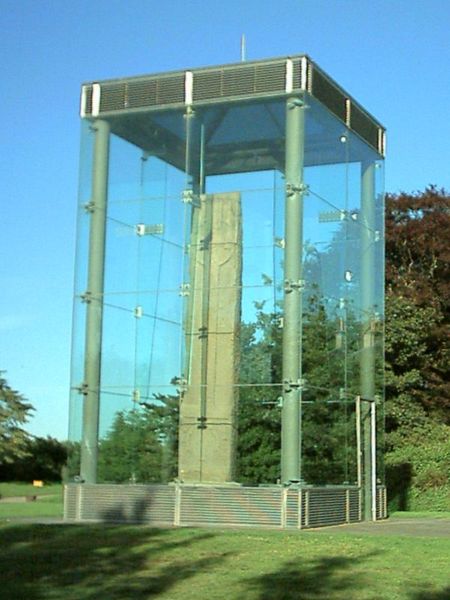|
Forres Tolbooth
The Forres Tolbooth is a municipal building on the High Street in Forres in Scotland. The building, which is used as a visitor attraction, is a Category A listed building. History The first tolbooth in Forres was completed in the mid-16th century. It was primarily used as a prison, but was in a ruinous condition by 1655. Extensive repairs were carried out in the 1670s and the late 1690s. A bell was installed in 1708 and a clock was installed in 1711. The foundation stone for the current structure was laid in 1838. It was designed by William Robertson in the Scottish baronial style, built in ashlar stone, and was completed in 1839. The design involved a five-stage tower facing southwest down the High Street. There was a round headed doorway with an archivolt in the first stage, a round headed window with an archivolt in the second stage, a corbelled parapet with corner bartizans at the top of the third stage, clock faces with more corner bartizans in the fourth stage, and a tall ... [...More Info...] [...Related Items...] OR: [Wikipedia] [Google] [Baidu] |
Forres
Forres (; ) is a town and former royal burgh in the north of Scotland on the County of Moray, Moray coast, approximately northeast of Inverness and west of Elgin, Moray, Elgin. Forres has been a winner of the Scotland in Bloom award on several occasions. There are many geographical and historical attractions nearby such as the River Findhorn, and there are also classical, historical artifacts and monuments within the town itself, such as Forres Tolbooth and Nelson's Tower. Brodie Castle, the home of the Brodie Clan, lies to the west of the town, close to the A96. Pre-history and archaeology Between 2002 and 2013 some 70 hectares of land was investigated by archaeologists in advance of a proposed residential development on the southern fringes of the town. They found an extensive Iron Age settlement and evidence that people lived in the area from the Neolithic British Isles, Neolithic (Radiocarbon dating, radiocarbon dates from the 4th to the mid-3rd millennium BC were found) ... [...More Info...] [...Related Items...] OR: [Wikipedia] [Google] [Baidu] |
Coffer
A coffer (or coffering) in architecture is a series of sunken panels in the shape of a square, rectangle, or octagon in a ceiling, soffit or vault. A series of these sunken panels was often used as decoration for a ceiling or a vault, also called ''caissons'' ("boxes"), or ''lacunaria'' ("spaces, openings"), so that a coffered ceiling can be called a ''lacunar'' ceiling: the strength of the structure is in the framework of the coffers. History The stone coffers of the ancient Greeks and Romans are the earliest surviving examples, but a seventh-century BC Etruscan chamber tomb in the necropolis of San Giuliano, which is cut in soft tufa-like stone reproduces a ceiling with beams and cross-beams lying on them, with flat panels filling the ''lacunae''. For centuries, it was thought that wooden coffers were first made by crossing the wooden beams of a ceiling in the Loire Valley châteaux of the early Renaissance. In 2012, however, archaeologists working under the Packa ... [...More Info...] [...Related Items...] OR: [Wikipedia] [Google] [Baidu] |
1839 Establishments In Scotland
Events January–March * January 2 – The first photograph of the Moon is taken, by French photographer Louis Daguerre. * January 6 – Night of the Big Wind: Ireland is struck by the most damaging cyclone in 300 years. * January 9 – The French Academy of Sciences announces the daguerreotype photography process. * January 19 – The British Aden Expedition captures Aden. * January 20 – Battle of Yungay: Chile defeats the Peru–Bolivian Confederation, leading to the restoration of an independent Peru. * January – The first parallax measurement of the distance to Alpha Centauri is published by Thomas Henderson. * February 11 – The University of Missouri is established, becoming the first public university west of the Mississippi River. * February 24 – William Otis receives a U.S. patent for the steam shovel. * March 5 – Longwood University is founded in Farmville, Virginia. * March 7 – Baltimore City College, the third public high school in the United States, ... [...More Info...] [...Related Items...] OR: [Wikipedia] [Google] [Baidu] |
Clock Towers In The United Kingdom
A clock or chronometer is a device that measures and displays time. The clock is one of the oldest Invention, human inventions, meeting the need to measure intervals of time shorter than the natural units such as the day, the lunar month, and the year. Devices operating on several physical processes have been used over the Millennium, millennia. Some predecessors to the modern clock may be considered "clocks" that are based on movement in nature: A sundial shows the time by displaying the position of a shadow on a flat surface. There is a range of duration timers, a well-known example being the hourglass. Water clocks, along with sundials, are possibly the oldest time-measuring instruments. A major advance occurred with the invention of the verge escapement, which made possible the first mechanical clocks around 1300 in Europe, which kept time with oscillating timekeepers like balance wheels., pp. 103–104., p. 31. Traditionally, in horology (the study of timekeeping), the ... [...More Info...] [...Related Items...] OR: [Wikipedia] [Google] [Baidu] |


